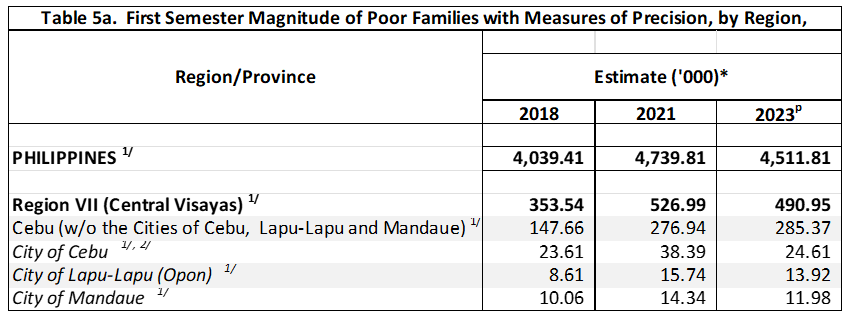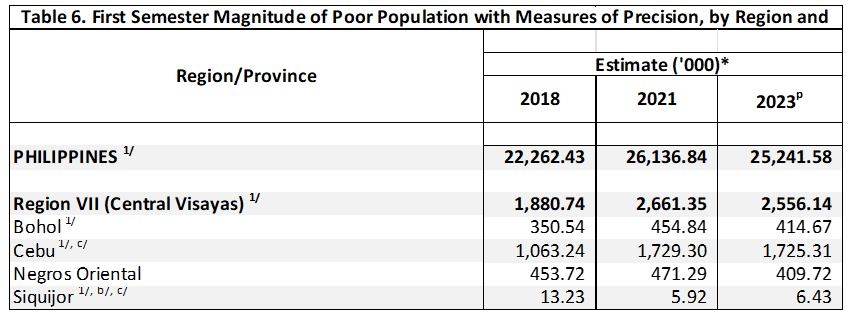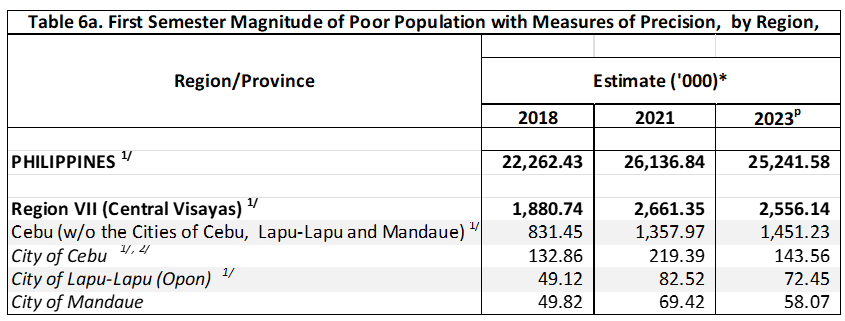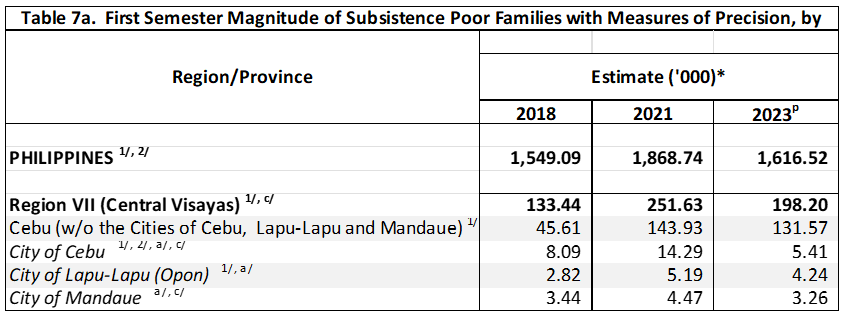1. Incidences and Magnitude
The 2023 Family Income and Expenditure Survey Visit 1 (FIES V1) preliminary results, which were completed in July 2023, indicate that 24.9 percent (336 thousand) of families in Cebu including the three Highly Urbanized Cities experienced poverty during the first semester of 2023. This represents the proportion of families whose incomes are insufficient to meet their basic needs for food and non-food items. The report is greater than the 16.5 (190 thousand) percent registered in 2018 but 2 percent below than the 345 thousand reported in 2021. (See Figure 1)
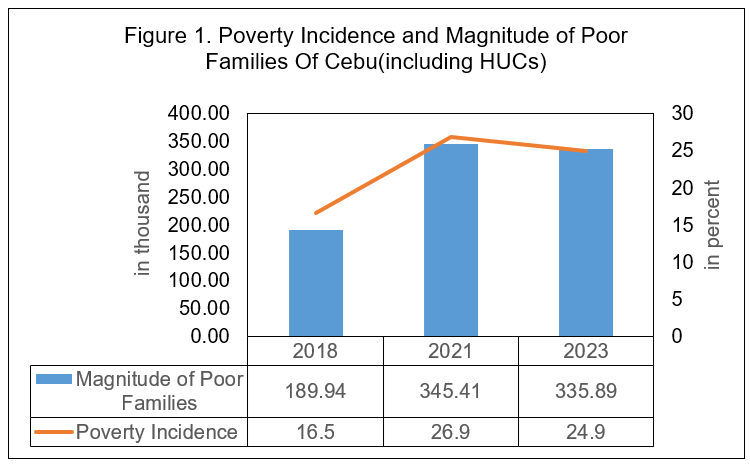
An estimated 1.725 million Cebuanos, or 32.5% of Cebu’s total population (including the HUCs), are estimated to fall below the poverty line. The report's percentage is 21.6 percent higher than the expected 2018 figure, however it is marginally lower than the projected 2021 figure of 1.729 million (33.5 percent). (See Figure 2)
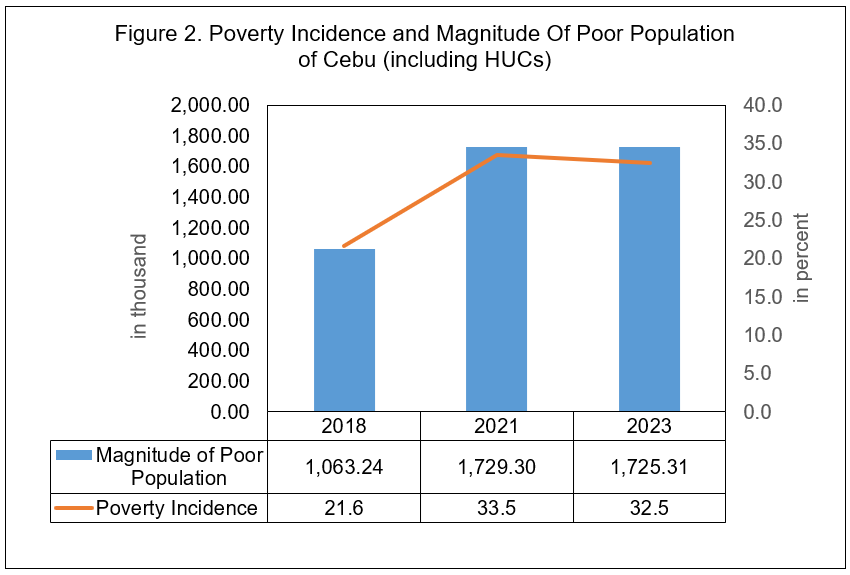
In the first semester of 2023, the subsistence incidence—that is, the percentage of families whose earnings are insufficient to cover their basic food needs in Cebu (including HUCs)—was approximately 10.7 percent or 11 out of every 100 families. This is equivalent to around 144 thousand families. The figure is lower than the reported subsistence incidence in 2021 which stood at 13.1 percent (168 thousand). Among individuals, 15 out of 100 or 813 thousand Cebuanos are considered subsistence poor. This is also lower than the projected 870 thousand subsistent poor individuals in 2021. (See Table A)
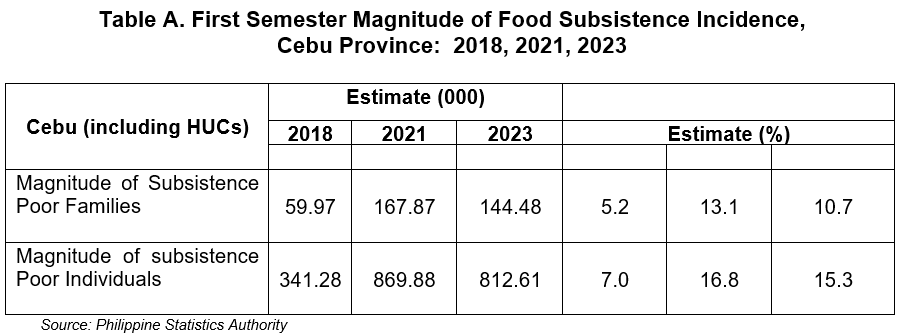
Across all domains, Cebu (excluding the three HUCs), registered the highest percentage of poverty and subsistence incidence among its population in the first semester of 2023. An estimated 1.45 million (42.4 percent) Cebuanos living outside the three highly urbanized cities of the province falls below the poverty line. Additionally, Cebu City also reported a sizable portion of its population (143 thousand) living below the poverty level (14.5 percent). While Lapu-lapu City with 14.7percent (72 thousand) and Mandaue City 14.4 percent (58 thousand) also exhibited double digit poverty percentage. (See table B)
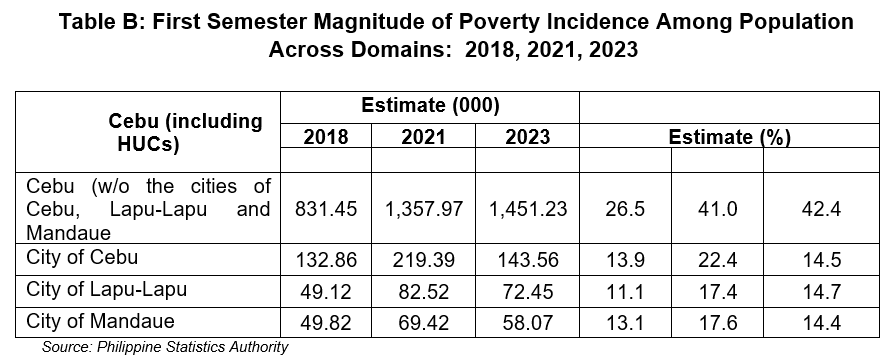
Moreover, Cebu (excluding the HUCs) also registered the largest magnitude of subsistence incidence across all domains. Based on the survey, 732 thousand or 21.4 percent of its population cannot afford to buy the basic food necessities. However, only a small percentage of the people in each of the three HUCs were reported to be food insecure. The lowest percentage, 4.8% (24 thousand), was recorded in Lapu-lapu City, followed by 4.5% (18 thousand) in Mandaue City. Cebu City, which has the largest population among the HUCs, reported 38 thousand as the least amount of people living in food poverty representing 3.9 percent of its population. (See table C)
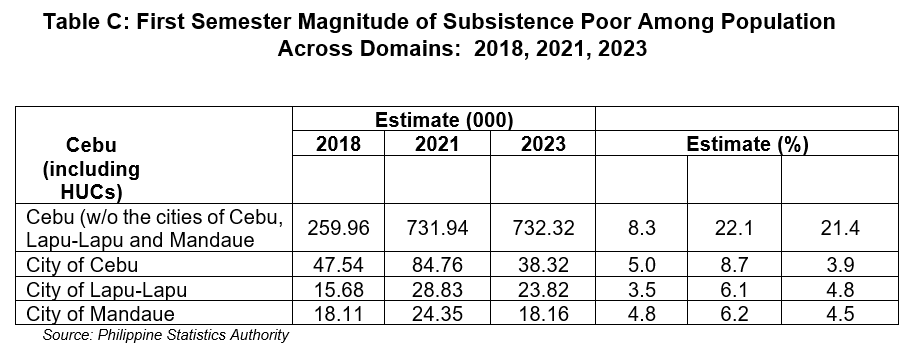
2. Thresholds and Income
Based on the survey's per capita poverty criteria, a family of five in Cebu (including the HUCs) would require at least Php 14,965 per month in the first semester of 2023 to cover their minimal needs for food and non-food items. The aforementioned figure, generally known as the poverty threshold, exceeded the projected monthly poverty threshold of Php 13,593 for a family of five in 2021 by 10.1%.
Across domains, a family of five in Cebu (excluding the three HUCs) will need Php 14,873 in order to afford the basic food and non-food requirements. This represents an increase of 10.5 percent from the estimated Php 13,486 threshold during the same period in 2021. Meanwhile the other three domains also posted positive increases in the poverty threshold. A family of five in Mandaue City, Cebu City and Lapu-Lapu City needs to have a monthly income above Php 15,504, Php 15,440 and 15,427 respectively to be considered non-poor.
On the other hand, to meet their minimum basic food needs in the first semester of 2023, a family with five members in Cebu (including the HUCs) will require at least Php 10,384 per month to cover their minimum basic food demands. This exceeded the predicted Php 9,443 food barrier in the first semester of 2021. Similarly, across all domains, a family of five in Mandaue City, Lapu-Lapu City, Cebu City and Cebu (excluding the HUCs) respectively needs Php 10,827, Php 10,782, Php 10,753 and Php 10,340 every month to afford the basic food necessities.
It is to be noted that income collected in the FIES refers to various sources, such as wages and salaries, entrepreneurial activities and other sources of income. The other sources of income include, net share of crops, cash receipts from abroad and from domestic source, rentals received, interest, pension, dividends, net receipts, those receives as gifts (in cash or in kind) and imputed rent. (See table D and E)

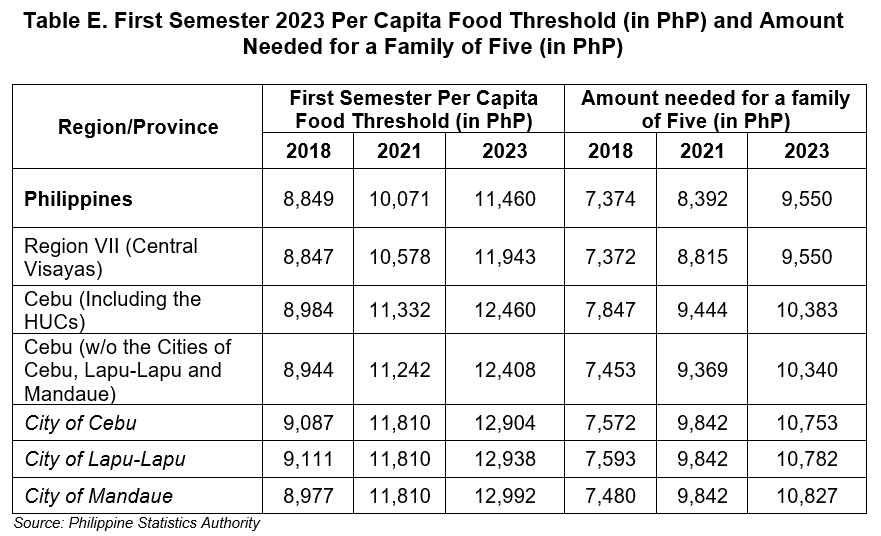
Approved by:
(SGD) MELCHOR B. BAUTISTA
Chief Statistical Specialist
LGCS/MAN
Glossary of Terms
Food threshold - the minimum income required for a family/individual to meet the basic food needs, which satisfies the nutritional requirements for economically necessary and socially desirable physical activities
Income Gap - the average income shortfall (expressed in proportion to the poverty threshold) of families/individuals with income below the poverty threshold divided by the total number of poor families/individuals
Note: The difference between the income gap and the poverty gap is the use of number of poor families/ individuals as denominator for the income gap. For the poverty gap, the total number of families/individuals is used.
Poverty gap - the total income shortfall (expressed in proportion to the poverty threshold) of families/ individuals with income below the poverty threshold divided by the total number of families/ individuals
Poverty incidence - the proportion of families/individuals with per capita income less than the per capita poverty threshold to the total number of families/individuals Poverty threshold - the minimum income required for a family/individual to meet the basic food and non-food requirements
Note: Basic food requirements are currently based on 100% adequacy for the Recommended Energy and Nutrient Intake (RENI) for protein and energy equivalent to an average of 2000 kilocalories per capita, and 80% adequacy for other nutrients. On the other hand, basic non-food requirements, indirectly estimated by obtaining the ratio of food to total basic expenditures from a reference group of families, cover expenditures on: 1) clothing and footwear; 2) housing; 3) fuel, light, water; 4) maintenance and minor repairs; 5) rental of occupied dwelling units; 6) medical care; 7) education; 8) transportation and communication; 9) non-durable furnishings; 10) household operations; and 11) personal care & effects.
Severity of poverty - the total of the squared income shortfall (expressed in proportion to the poverty threshold) of families/ individuals with income below the poverty threshold divided by the total number of families/ individuals
Note: This is equal to the Foster-Greer-Thorbecke (FGT) family of measures with alpha = 2. It is a poverty measure, which is sensitive to the income distribution among the poor – the worse this distribution is, the more severe poverty is.
Subsistence incidence - the proportion of families/individuals with per capita income less than the per capita food threshold to the total number of families/ individuals.







